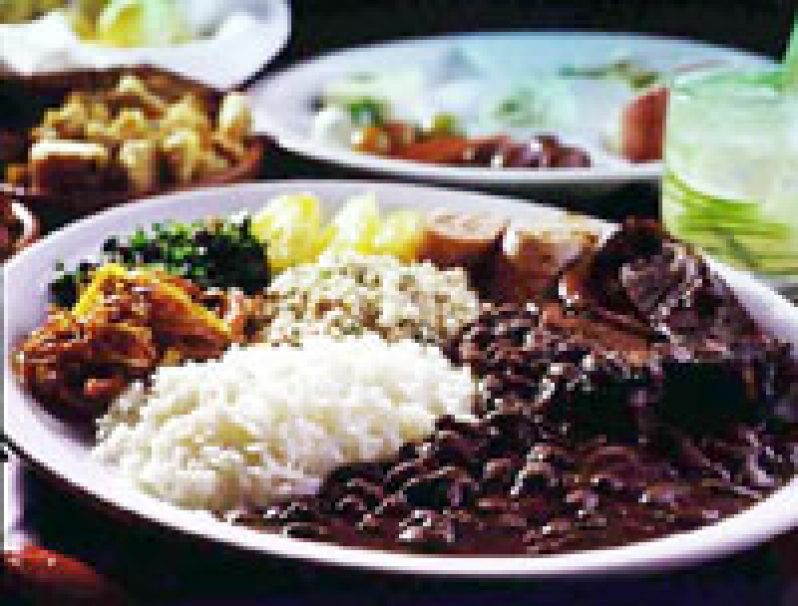PERHAPS it was rice that Guyanese food writer, Cynthia Nelson described as the ultimate comfort food in her article, “Comfort in a bowl of Rice”, in the September 27, 2008 edition of her Tastes like Home column of the Stabroek News; or perhaps she was alluding to the appeal of an easy one-pot dish, using what you have, but it seems all the world loves a rice-and-bean dish.
 In this hemisphere, variants include our “cook-up rice”, which includes as ingredients black-eyed peas and coconut milk; “Hoppin Juan”, which substitutes Cuban black beans for black-eyed peas; and the Brazilian dish Feijoada, which uses black turtle beans instead of black-eyed peas.
In this hemisphere, variants include our “cook-up rice”, which includes as ingredients black-eyed peas and coconut milk; “Hoppin Juan”, which substitutes Cuban black beans for black-eyed peas; and the Brazilian dish Feijoada, which uses black turtle beans instead of black-eyed peas.
Cook-up rice is defined by Nelson on About.com as: “A one-pot rice dish that consists of rice, a variety of meats, and fresh herbs that are cooked with coconut milk,” and has its origins as a peasant dish that was actually traditionally created and made to be eaten at the end of the week when rations would have been depleted.
Bits of leftover meat would be cooked with rice and peas or beans, and this dish was well seasoned with the addition of fresh herbs such as thyme, green onions and basil, along with onions and tomatoes. Coconut milk added even more richness and flavor to the pot.
In Guyana, cook-up rice is a must-have dish on Old Year’s Night (New Year’s Eve), when large pots of cook-up rice are made, with the bean of choice usually being black-eye peas.
 In Trinidad and Tobago, the dish called pelau (pilaf) carries many of the same characteristics as the Guyanese cook-up rice, and is cooked in a seasoned broth. In some cases, the rice may also attain its brown colour by being stirred with bits of cooked onion as well as a large mix of spices, and this could also contain meat and vegetables.
In Trinidad and Tobago, the dish called pelau (pilaf) carries many of the same characteristics as the Guyanese cook-up rice, and is cooked in a seasoned broth. In some cases, the rice may also attain its brown colour by being stirred with bits of cooked onion as well as a large mix of spices, and this could also contain meat and vegetables.
Other sources have compared our Cook-up to Jollof rice, also called Benachin, a popular dish in many parts of West Africa. It is thought to have originated amongst members of the Wolof ethnic group in the Senegambia region, but has since spread to the whole of West Africa, especially Nigeria, Togo, Ghana, Sierra Leone and Liberia. Though there are many variations of Jollof rice, the most common basic ingredients are rice, tomatoes and tomato paste, onion, salt, and red pepper.
Beyond that, nearly any kind of meat, vegetable, or spice can be added. Cooking Jollof rice begins with using oil to fry finely-chopped onions, tomatoes and ground pepper (plus any other optional seasoning); adding stock; and then cooking the rice in this mixture so it takes up all the liquid. The rice takes on a characteristic orange colour from the mixture.
It can be served with cooked meat, chicken, fish, or vegetables being placed separately on the plate, or stirred in at the end. It is often served with fried plantain and salad.
Hoppin’ John is a dish served in the Southern United States. It consists of black-eyed peas and rice, with chopped onion and sliced bacon, seasoned with a bit of salt. Some people substitute other meats for the conventional bacon; a few use green peppers or vinegar and spices. Field peas, which are smaller than black-eye peas, are used in the Low Country of South Carolina and Georgia; black-eyed peas are the norm elsewhere.
As with Cook-up in Guyana, in the Southern United States, eating Hoppin’ John on New Year’s Day is thought to bring a prosperous year filled with luck. On the day after New Year’s Day, leftover “Hoppin’ John” is called “Skippin’ Jenny”.
Jambalaya originated in the Caribbean islands when the Spanish culture mixed with the native foods. Jambalaya is traditionally made in three parts with meats and vegetables, and is completed by adding stock and rice. It is also a close cousin of the saffron coloured paella, found in Spanish cuisine.
Jambalaya is differentiated from gumbo and étouffée by the way in which the rice is added. In these dishes, the rice is cooked separately, and is served as a bed on which the main dish is served. In the usual method of preparing jambalaya, a rich stock is created from vegetables, meat, and seafood; raw rice is then added to the broth, and the flavour is absorbed by the grains as the rice cooks.
Spanish rice is popular in Spain and Mexico (though it is not so called there). It’s made from white rice, tomatoes, garlic, onions, and other ingredients. It is traditionally made by sautéing the rice in a skillet. Water or chicken broth is then added, along with chopped tomatoes or tomato sauce.
Rice and Peas is a Bajan favourite. It is made of long grain parboiled rice. Many Barbadians opine that a Sunday meal is incomplete without a rice dish. Though no coconut milk is used, like cook-up, it can be made with any meat of choice, pigeon peas and Bajan seasoning — a blend of fresh herbs such as thyme, marjoram, spring onions, onions, garlic, parsley, basil and scotch bonnet pepper with spices such as clove, black pepper, paprika and salt.
So, for the people who don’t feel like they had a meal without rice, take comfort that you are not alone in your feeling.



.jpg)








